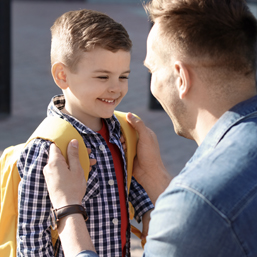
Going back to school can be an exciting time in a child’s life. New classmates, new teachers, new environment... but all this newness can also be challenging for our little ones. Leaving mom and dad to go to school or daycare can cause a stir of emotions. After a few tearful attempts, we may start to become frustrated and feel lost on how to better support morning drop-offs and ease their anxieties.
So, why is it so hard for our children to leave us in the morning? Well, it all starts with attachment. Our children often feel safest at home. They generally know the expectations we will have of them, the responses we will give to them, all their favorite items are there, and it’s a place where everyone will unconditionally love them.
School is a little less predictable. It’s a place where they must learn new routines, new adult response patterns, navigate social situations, they will inevitably be faced with small failures or frustrations, and they will be asked to learn lots of new things, which can feel really daunting.
For some children, getting dropped off every day at school or daycare can feel like that security blanket of safety and love is getting snatched away. This sensation, combined with the unknown of what the school day will bring, can create feelings of overwhelm and anxiety. These feelings are very common for most children, and for some children these feelings of overwhelm during drop-off might linger longer for them than for their peers.
Now, let’s talk about the good stuff – how can I help my child throughout these morning transitions? Here are a few of our top tips to make the drop-offs run a little more smoothly:
Create a goodbye ritual. We love the books The Kissing Hand by Audrey Penn and The Invisible String by Patrice Karst. These books help a young child to understand how parents or people they love are always with them, thinking about them, and supporting them, even if they aren’t physically there. Reading one of these books and pairing it with a small bracelet, necklace or heart stamp on your child’s hand can provide a tangible reminder that you are always supporting and loving them from afar.
Other fun goodbye rituals could be secret handshakes, a special hug goodbye, or a small transition object from home that they can take with them into the classroom. Depending on your child’s age you could brainstorm with them. What is a goodbye ritual they would like to build with you?
Routine visuals. Part of what makes drop off tricky is the unknown. Ask your child’s teacher for the first couple activities in the classroom schedule, then create a routine strip of visuals for your child (or if you have a reader, you can make a short list). Include all the steps they will need to do in the morning routine at home, then show them the first couple of things that will be happening once they get to school. We all feel a bit more confident when we know what will be expected of us when we get somewhere. If your child is having a hard time getting ready at home, you can work in some regulating activities as well, like listening to music while eating breakfast, taking a couple minutes to decompress with a book or toy before leaving the house, or taking a favorite snack with them in the car on the drive to school.
Model confidence. Our children look to us to determine how they should feel about a situation. They may watch us and think “wow, my parents aren’t feeling too sure, maybe there is something for me to feel nervous about as well.” Keep drop-offs positive, confident and brief. Never sneak away from your child, take a moment to validate their feelings, remind them of when you will see them again, and confidently pass them off to their teacher or another support person. Even though you may feel nervous, frustrated or rushed, try to keep yourself calm, cool and collected so your child has confidence!
Create a relationship with school staff. This strategy is twofold. By creating a positive relationship with our child’s teacher or the school staff that support them, we are modelling for our child that these adults are kind, supportive and trustworthy. This is also helpful in building a collaborative morning transition plan with your child’s teacher. You can make a plan with the teacher so that they are ready and prepared with any tools, activities or support that may help your child enter the classroom more calmly. This might require some trial-and-error testing to see what works best, but teachers are always eager to collaborate with parents, so don’t ever be afraid to ask for help!
As frustrating as this process can feel, it is important that we follow our child’s lead. For some children, implementing a few strategies can be enough to calm their worries, while other children can take much longer to successfully transition to school in the mornings. Take a deep breath, try a few strategies and be patient with the process. If you believe that your child is struggling significantly more than other children their age are, it’s always good to seek out professional support. You can collaborate with a psychologist, counsellor or doctor to make a plan to support your child, and explore what is going on that they may need support with.
Ashlee and Lisa are child psychologists who created KidsConnect Psychology as a place for children and families to access tools, supports and therapy. Check out their website for digital downloads, parenting tool kits, information about their parent counselling, school consultations, daycare consultations and more! kidsconnectpsychology.com. Follow them on Facebook and Instagram at KidsConnect Psychology.
See our related articles:
Calgary’s Child Magazine © 2024 Calgary’s Child